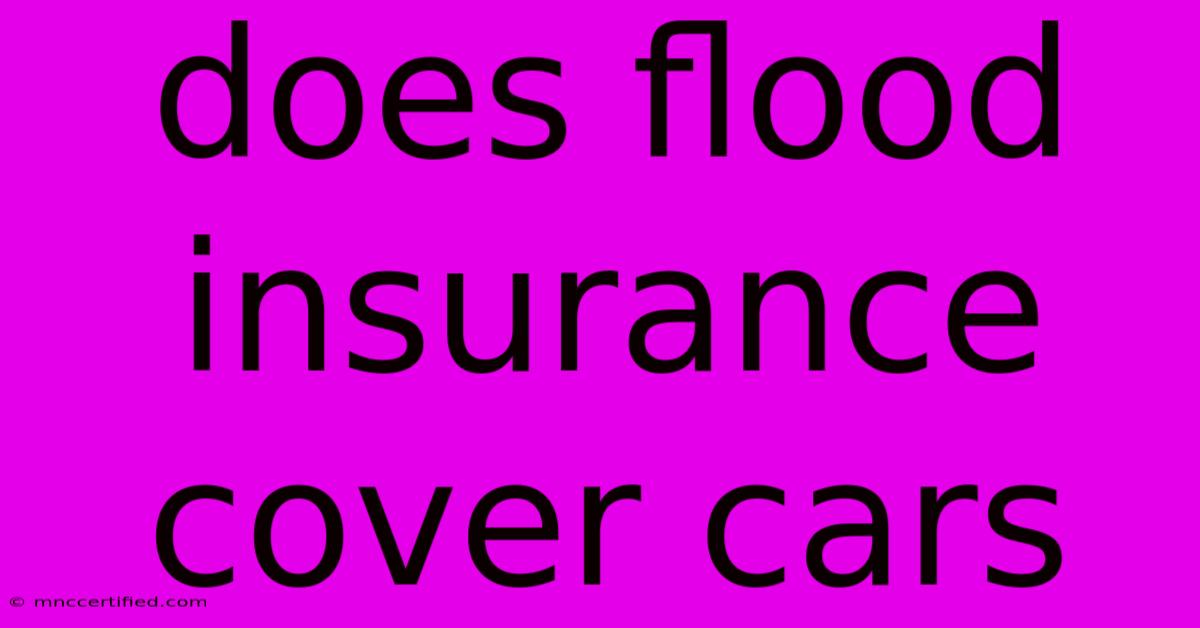Does Flood Insurance Cover Cars

Table of Contents
Does Flood Insurance Cover Cars? A Comprehensive Guide
Flooding is a devastating event, causing widespread damage and significant financial losses. While many homeowners are aware of the importance of flood insurance for their property, a common question arises: does flood insurance cover cars? The short answer is: it depends. This comprehensive guide will delve into the specifics of flood insurance and its coverage for vehicles.
Understanding Flood Insurance Policies
Flood insurance is typically purchased separately from homeowners or renters insurance. It's offered through the National Flood Insurance Program (NFIP) in the United States and through private insurers. Crucially, standard homeowners and auto insurance policies generally do not cover flood damage. This is why purchasing a dedicated flood insurance policy is essential if you live in a high-risk flood zone or even a moderate-risk area.
What Flood Insurance Typically Covers
Flood insurance policies primarily cover the structure of your home and its contents. This includes things like:
- Building: The physical structure of your house, including the foundation, walls, and roof.
- Contents: Personal belongings inside your home, such as furniture, appliances, and clothing.
However, the coverage for personal property often has limitations, and vehicles are usually a gray area.
Does Flood Insurance Cover Your Car?
The answer to this question is often no, at least not directly through a standard NFIP policy. While your homeowner's policy might cover your car if it's damaged in a flood while parked in your garage, it's unlikely to cover it if it's parked outside or in a different location.
To ensure your car is covered in a flood, you'll typically need to purchase comprehensive coverage on your auto insurance policy. This type of coverage protects against damage caused by a variety of events, including floods, fire, theft, and vandalism. Comprehensive coverage is optional, but highly recommended for anyone living in an area with a risk of flooding.
Checking Your Policies: The Fine Print
It's vital to thoroughly review both your flood insurance and auto insurance policies. Look for specific clauses regarding flood damage and vehicle coverage. Pay attention to:
- Exclusions: Flood insurance policies often explicitly exclude coverage for vehicles.
- Deductibles: Understand the deductible amount you'll need to pay out-of-pocket before your insurance coverage kicks in.
- Coverage Limits: Know the maximum amount your insurance will pay out for flood damage to your car.
Filing a Claim
If your car is damaged in a flood, immediately contact both your flood insurance company (if applicable) and your auto insurance company to report the damage and initiate a claim. Gather as much evidence as possible, including photos and videos of the damage and the flooded area.
Protecting Yourself from Flood Damage
Prevention is always better than cure. Here are some steps to mitigate flood damage to your car:
- Park your car on higher ground: If you anticipate flooding, move your car to a safer location.
- Consider purchasing comprehensive auto insurance: This is the best way to protect your vehicle from flood damage.
- Purchase flood insurance for your home: While it may not directly cover your car, it protects your most valuable asset.
- Stay informed about weather forecasts: Monitor weather reports and take precautions when severe weather is predicted.
Key Takeaways:
- Standard flood insurance policies usually do not cover cars.
- Comprehensive auto insurance is crucial for flood protection.
- Review your policies carefully to understand your coverage.
- Take preventative measures to minimize flood risk.
By understanding the limitations of flood insurance and taking proactive steps, you can better protect your vehicle and your finances in the event of a flood. Remember, the key is preparation and understanding your insurance coverage completely. Contact your insurance providers for clarification on any specifics in your policies.

Thank you for visiting our website wich cover about Does Flood Insurance Cover Cars. We hope the information provided has been useful to you. Feel free to contact us if you have any questions or need further assistance. See you next time and dont miss to bookmark.
Featured Posts
-
Xiao Longs Knockout Ufc 248
Nov 23, 2024
-
Chester Security Alert Bus Station Evacuated
Nov 23, 2024
-
Turners East Enders Departure Planned
Nov 23, 2024
-
Shortest Meets Tallest Woman
Nov 23, 2024
-
Coldplay Extra Uk Tour Tickets
Nov 23, 2024